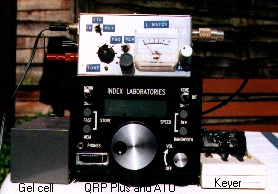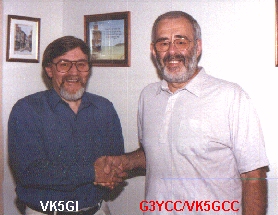

For my second trip to Australia, I decided to take an HF rig, having been disappointed with the results on 2m FM last time I went in 1995. Originally I thought I would take a monobander, possibly homebrew CW but thanks to advice given over the Internet, it was obvious a rethink was needed, as band conditions can vary, and if only one option was available, the results would have been not worth while. Obviously a multibander was needed, after all I didn't know how amateur radio would be different to the UK. Antennas would be a problem, as we were to tour about a bit. All these matters needed some deliberation. I decided on an Index Labs QRP Plus transceiver which would give me all the bands I wanted to use. It proved to be a good choice, especially as CW would be the mode of most use, but with SSB as an alternative. As it turned out, all my QSOs were on CW. ANTENNAS What to take, not knowing what would be available in the way of supports. Clearly, all equipment had to be small and lightweight if possible (everything gets heavier the further you carry it!) and all had to be transported in hand luggage. I decided to take a 33 foot antenna wire and a 17 foot counterpose and made an L-Match tuner, which on tests at the home QTH, worked out well on 7, 10.1 and 14 mhz. It may be worthwhile mentioning that the ONLY way to be sure you have all you need with you, is to set up the station as it will be in the remote location. You can not be sure that odd item you didn't pack can be replaced when you get there! Like a patch lead, power connector etc. POWER SUPPLY This was another important consideration, especially with weight in mind. I ruled out lugging a mains PSU with me and decided to purchase a gel cell and charger when I arrived and leave it behind as a gift to my host-cum-brother-in-law! Gel cells are a no-no anyway on aircraft as they contain sulphuric acid, a risk I decided was not worth while. There were other possibilities considered, but that was the decision I made. OTHER EQUIPMENT This included keyer, various leads in duplicate, just in case of failure, some basic tools (screw driver, small pliers, side cutter and, most importantly a roll of PVC tape). Spare antenna wires and counterpoises were taken as a safeguard. It is easy to loose a bit of wire up a tree! Ordinary multi strand thin, plastic covered wire was used, as I don't believe it really matters what you use on HF QRP. DOCUMENTATION As Austalia is not covered by the CEPT agreement, I needed to obtain my VK5 licence. I had obtained VK5GCC on my last trip, and therefore knew how to go about it. I would need my Validation Document and the requisite dollars (about £17.00 for four months). It is also worth taking with you any receipts for gear, this assisting with customs. I caused a bit of a stir at the various customs posts as we went (via Singapore), but was able to satisfactorily explain the wires and electronics in my hand luggage. Generally it is worth taking the UK licensing conditions with you also. In VK, licences are available over the counter in a few minutes at the Spectrum Agency of the State you are in. FIRST IMPRESSIONS. The station was first set up at Taggerty, Victoria where we stayed in a cabin, with the wire thrown into a gum tree. I guess the height would be at most 18 feet. Initial listening tests on 40m were alarming. No QRM, no signals in the morning, nothing! The rig's bust, the antenna is down, the ATU is open circuit... these were my initial gut feelings, after all in UK there was always something to hear on 40 even though it was QRM! The reason being the band was so QUIET! Uncluttered, and so it was on 20m and 30m. Later in the day, up came the signals and VK2SU, Freda in Griffith was worked, getting a 579 report - we were in business. And so it continued throughout the five weeks we were in VK. The bands are SO QUIET! Brilliant. RESULTS Operation was 0n 40, 30 and 20m with the same end fed 33 ft wire and L Match. 40m - KH8 (Amer-Samoa), CM2 (Cuba), GM3JKS (Scotland - two QSOs), VKs - 1,2,3,4, ZLs. No G's were worked, but G4BUE (Chris) came bounding through on 40 working VK and ZL, a very big signal with his QRO. Did call you Chris but so did half the World! 20m - proved to be the best DX band, working European Stations: LZ,EX8, S51, OK,RA9 Also worked FR5 (Reunion), JAs, ZS6 (S Africa), HL (Korea), P29 (PNG), YB (Indonesia), VKs and ZLs. 30m - not used much, but ZK1 (Cook Islands) and VK2 were worked. This band too was relatively quiet, unlike back home. I MEET A REAL LIVE VK5 QRPer!

The above shows myself with Norm, VK5GI a fellow G QRPer (Nr. 9348). We had a very pleasant night with him and I am most grateful to Norm for his help in preparing for my trip, radiowise, down under. A man with a brilliant sense of humour, enjoyed by my family in Elizabeth and with whom I have quite a bit in common, apart from radio. We have the same surname, both were 'technicians' in the Health Service, my sister in SA and his XYL have the same first name, his wife is a Yorkie like me, we both are in the G QRP Club etc, etc! I will cherish memories of meeting Norm for many a year. GENERAL OBSERVATIONS. I suppose the two QSOs with GM3JKS were the high light of the operation, but a VK/VK contact also was memorable for me. Several years ago, I called CQ on 20m, CW with one watt output to a dipole and was answered by Snow, VK3MR. I managed to work him this holiday from Elizabeth Downs, Adelaide. This struck me as unusual, working a VK3 as a G, then many years pass and I work him as VK5GCC! Must be a record! No US stations were worked, several times I tried but was unlucky. All the QSOs were on CW, all on the QRP Plus and all using the end fed wire. I wonder what would have been worked with a beam! Still it was a great adventure on the air, and although I did not spend a lot of time operating (the main reason for the holiday was to see family and do a bit of touring - including Alice Springs, Ayre's Rock, Melbourne etc). I did notice plenty of packet activity on the bands, including 7.035 and CW up to 7.040 mhz. 10.106 mhz was hit by QRM as it is in G land. Packet was evident on 14.060, a change from Amtor - on the 'QRP frequency'! In one location, Victor Harbor SA, the bed springs were found to be a good earth! 20m didn't seem to 'wake up' at all until 1500 local any day, but stayed open quite late. When it was open, JAs were in evidence on SSB over the whole band, seemingly having a band plan unknown to me! Although I had quite a few QSOs, I never heard or worked any QRPers at all! It was a revelation though, to both listen and have QSOs on the bands from 'Oz'.
Frank, G3YCC.